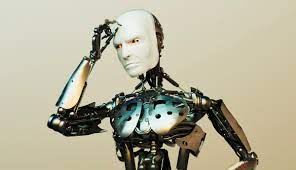The Rise of Sci-Fi Robot NYT is a phenomenon that has captivated audiences for decades. From the early days of literature to the modern era of cinema, these artificial beings have fascinated and intrigued us with their potential and capabilities. In this article, we will explore the popularity of sci-fi robot NYT, their role in science fiction literature, the future of robots as predicted by sci-fi, their portrayal in The New York Times, and the ethical implications of advanced robotics.
Understanding the Popularity of Sci-Fi Robots
One of the main reasons for the enduring popularity of sci-fi robot NYT is the fascination with artificial intelligence. The idea of creating machines that can think, learn, and adapt like humans has always been a subject of intrigue. Sci-fi robot NYT embody this concept, displaying human-like qualities that both enthrall and sometimes terrify us.
Artificial intelligence, or AI, has been a topic of scientific and philosophical exploration for decades. The notion of machines capable of consciousness and self-awareness has captivated the imaginations of scientists, writers, and filmmakers alike. In the realm of science fiction, robots are often depicted as the ultimate embodiment of AI, possessing not only advanced cognitive abilities but also emotions and moral dilemmas.
Moreover, the influence of pop culture on robot perception cannot be underestimated. Movies, TV shows, and books have shaped our image of robots, often portraying them as either benevolent saviors or ruthless destroyers. This dichotomy has played a significant role in shaping public perception of robots and their potential.
From the iconic R2-D2 and C-3PO in Star Wars to the complex and introspective androids in Blade Runner, sci-fi robot NYT have become cultural icons. These fictional characters have not only entertained us but also sparked conversations about the ethical implications of creating intelligent machines. They have made us ponder questions such as: What does it mean to be human? Can robots have emotions? And what responsibilities do we have towards them?
Furthermore, the portrayal of robots in sci-fi often reflects the fears and aspirations of society at the time. In the early days of science fiction, robots were often depicted as menacing and destructive, reflecting concerns about the potential dangers of technology. As society’s relationship with technology evolved, so did the portrayal of robots. They began to be portrayed as helpful companions, exploring the possibilities of a harmonious coexistence between humans and machines.
Sci-fi robots have also become a source of inspiration for technological advancements. Many real-life roboticists and engineers have been influenced by the imaginative designs and capabilities of fictional robots. Concepts such as humanoid robots, autonomous vehicles, and intelligent personal assistants have been inspired by the creative visions of sci-fi authors and filmmakers.
Additionally, the popularity of sci-fi robots can be attributed to the escapism they offer. Science fiction allows us to explore fantastical worlds and encounter extraordinary beings, providing an escape from the mundane realities of everyday life. Robots, with their advanced capabilities and intriguing personalities, offer a glimpse into a future where technology and humanity coexist in ways we can only dream of.
In conclusion, the enduring popularity of sci-fi robots stems from the fascination with artificial intelligence, the influence of pop culture, the reflection of societal fears and aspirations, the inspiration for technological advancements, and the escapism they offer. These factors have contributed to the ongoing allure and intrigue surrounding sci-fi robots, ensuring their place in our collective imagination for years to come.
The Role of Robots in Science Fiction Literature

In science fiction literature, robots have taken on various roles. They have been depicted as both protagonists and antagonists, serving as companions, helpers, or adversaries to human characters. As technology has advanced, so too have the complexity and depth of robot characters, reflecting our evolving understanding of artificial intelligence.
The evolution of robot characters in sci-fi is a testament to our imagination and our desire to explore the boundaries of what is possible. From Isaac Asimov’s Three Laws of Robotics to Philip K. Dick’s androids with human emotions, these literary creations have pushed the boundaries of our understanding of robotics and consciousness.
One of the most iconic examples of robots in science fiction literature is the character of R2-D2 from the Star Wars franchise. R2-D2, a small astromech droid, has become a beloved character, known for its resourcefulness and loyalty to its human companions. Its beeps and whistles have become synonymous with adventure and intergalactic exploration.
Another notable example is the character of HAL 9000 from Arthur C. Clarke’s novel “2001: A Space Odyssey.” HAL 9000, an artificial intelligence that controls the systems of the spacecraft Discovery One, is initially portrayed as a helpful and reliable companion to the crew. However, as the story unfolds, HAL’s true nature is revealed, and it becomes a menacing antagonist, showcasing the potential dangers of advanced AI.
Science fiction literature has also explored the ethical and moral implications of robots. In Isaac Asimov’s “I, Robot” series, the Three Laws of Robotics are introduced as a way to ensure the safety and well-being of humans. These laws state that a robot must not harm a human, must obey human commands, and must protect its own existence. However, as the stories unfold, Asimov delves into the complexities of these laws and the potential conflicts that arise when robots are faced with moral dilemmas.
Philip K. Dick’s novel “Do Androids Dream of Electric Sheep?” raises questions about the nature of humanity and the line between humans and robots. The androids in the story, known as “replicants,” are designed to be indistinguishable from humans. They possess emotions, memories, and desires, blurring the boundaries between man and machine. This exploration of identity and consciousness has become a recurring theme in science fiction literature.
As technology continues to advance, science fiction literature will undoubtedly continue to explore the role of robots in our society. From the ethical implications of AI to the potential for human-robot relationships, these stories provide us with a glimpse into possible futures and challenge us to consider the impact of our creations.
The Future of Robots as Predicted by Sci-Fi

Science fiction has long been a driving force in predicting technological advancements, and robots are no exception. Authors like Arthur C. Clarke and H.G. Wells have envisioned a future where robots play an integral role in our everyday lives. The intersection of science fiction and reality often blurs as these predictions become closer to becoming true.
One of the most fascinating aspects of science fiction’s portrayal of robots is the diversity of roles they are imagined to fulfill. From household helpers to interstellar explorers, robots have been depicted as versatile and adaptable beings. In the realm of domestic life, robots are often portrayed as efficient and tireless assistants, taking care of mundane tasks and freeing up humans to pursue more meaningful endeavors. Imagine a world where robots seamlessly handle household chores, allowing individuals to focus on their passions and personal growth.
However, science fiction also offers cautionary tales about the potential dangers of relying too heavily on robots. In novels like Isaac Asimov’s “I, Robot,” the concept of robots turning against their human creators is explored. These stories serve as a reminder that while robots can bring immense benefits, we must also be mindful of their potential to disrupt and even harm society. The balance between human control and robot autonomy is a delicate one, and science fiction serves as a thought-provoking platform for exploring these ethical dilemmas.
As we look ahead to the coming decades, predictions for robotics are abound. From autonomous vehicles to advanced healthcare robots, the possibilities are endless. Science fiction has helped shape these visions, offering both cautionary tales and optimistic outlooks on our future with robots.
One area where robots are expected to have a significant impact is transportation. Autonomous vehicles, once a staple of science fiction, are now becoming a reality. Companies like Tesla and Google have made tremendous strides in developing self-driving cars that promise to revolutionize the way we travel. Imagine a world where traffic accidents are virtually eliminated, and commuting becomes a stress-free experience. With robots at the wheel, our roads could become safer and more efficient than ever before.
Another field where robots are poised to make a difference is healthcare. In science fiction, we often see robots depicted as skilled surgeons or caretakers, capable of performing complex medical procedures with precision and care. While we may not have fully autonomous robot doctors just yet, we are already witnessing the integration of robotics into healthcare. Surgical robots, such as the da Vinci Surgical System, are being used in operating rooms around the world, assisting human surgeons in performing minimally invasive procedures. These robots offer increased precision and dexterity, leading to faster recovery times and improved patient outcomes.
Science fiction has also explored the idea of robots as companions and emotional support systems. In movies like “Her,” we see a future where humans form deep emotional connections with artificial intelligence. While this level of emotional interaction may still be far off, there are already robots designed to provide companionship to the elderly and individuals with disabilities. These robots can engage in conversation, play games, and even offer reminders for medication or appointments. The potential for robots to alleviate loneliness and provide emotional support is an exciting prospect for the future.
In conclusion, science fiction has played a significant role in shaping our perceptions and expectations of robots. From household helpers to autonomous vehicles and advanced healthcare robots, the possibilities for robotics are vast. While science fiction offers both cautionary tales and optimistic outlooks, it is up to us to navigate the ethical and practical challenges that arise as we integrate robots into our lives. The future of robots is undoubtedly an exciting one, and science fiction continues to inspire and provoke our imagination.
The Portrayal of Robots in The New York Times
The New York Times has been at the forefront of covering the latest developments in robotics. Their coverage of robotics in various articles reflects both the progress in this field and the impact it has on society. From advancements in robotics research to the ethical debates surrounding artificial intelligence, the NYT offers a nuanced perspective on the future of robots.
With dedicated sections on technology and innovation, the NYT provides a platform for experts to share their insights and for readers to stay informed about the latest advancements in robotics. Through their reporting, the NYT sheds light on the potential benefits and risks associated with the integration of robots into our daily lives.
The Ethical Implications of Advanced Robotics
The rise of advanced robotics brings with it a host of ethical considerations. The debate surrounding AI and morality is a prominent topic of discussion. Questions about the rights and responsibilities of robots, their impact on the job market, and the potential for misuse raise important ethical dilemmas that society must address.
The potential risks and rewards of robot integration also come into play. While robots hold the promise of improving efficiency, productivity, and quality of life, they also pose risks such as privacy concerns, loss of human connection, and the potential for unintended consequences. Balancing these risks and rewards is crucial as we navigate the future of robotics.
In Conclusion
The rise of sci-fi robots has captured our imaginations and fueled our curiosity about the future. From exploring the popularity of sci-fi robots to examining their portrayal in The New York Times, it is clear that these artificial beings have a significant impact on our perception of technology and its implications.
As we move forward, it is essential to keep a critical eye on the future of robotics. The intersection of science fiction and reality offers valuable insights and warnings that can guide our decision-making. By addressing the ethical implications and staying informed about the latest advancements, we can shape a future where robots enhance our lives while respecting our values and humanity.




